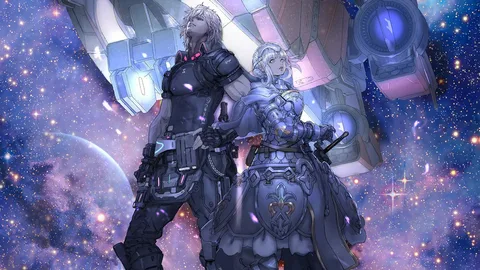Introduction to Star Ocean: Second Story R
Star Ocean: Second Story R is a remastered version of the classic science fantasy RPG originally released for the PlayStation in 1998. The game follows the story of Claude C. Kenni, a member of the Earthling Resettlement Committee, as he embarks on an interstellar adventure after crash-landing on an underdeveloped planet. Along the way, he meets a diverse cast of characters from various worlds and civilizations, each with their own unique abilities and backgrounds.
One of the standout features of Star Ocean: Second Story R is its deep character customization system. Players have the freedom to create their party members from scratch, allocating stat points, selecting skills, and customizing equipment to suit their preferred playstyle. This level of customization not only allows for a personalized gaming experience but also encourages experimentation with different character builds and party compositions.
The ability to tailor each character’s strengths and weaknesses adds an extra layer of depth to the game’s combat and exploration mechanics. Players can create a well-rounded party capable of tackling any challenge or specialize in specific roles to exploit enemy weaknesses. The customization options also extend to the game’s crafting and synthesis systems, allowing players to create powerful gear and items tailored to their party’s needs.
Overall, Star Ocean: Second Story R’s character customization is a defining aspect of the game, offering players a level of control and freedom rarely seen in RPGs of its era. Whether you prefer to min-max your party for optimal performance or simply create a diverse group of heroes that complement each other, the game’s customization options ensure a unique and engaging experience for every player.
Character Creation and Customization Options
In Star Ocean: Second Story R, players are presented with a comprehensive character creation system that allows for a high degree of customization. Upon starting a new game, you’ll be prompted to create your main protagonist, choosing from a variety of races, each with their own unique traits and attributes.
The available races include Humans, Expellians, Fellpool, and Terilians, each offering distinct advantages and disadvantages. Humans are the balanced all-rounders, while Expellians excel in magic and intelligence-based skills. Fellpool are physically strong and durable, making them ideal for melee combat roles. Terilians, on the other hand, are agile and nimble, excelling in dexterity-based abilities.
After selecting your race, you’ll have the opportunity to customize your character’s appearance, including facial features, hairstyles, and color schemes. This level of customization ensures that your character stands out from the crowd and truly reflects your personal preferences.
Next, you’ll choose your character’s class, which determines their starting skills, equipment proficiencies, and overall combat role. The available classes range from classic archetypes like Warriors, Mages, and Rangers, to more specialized options like Fencers, Assassins, and Symbologists. Each class has its own unique set of abilities and skill trees, allowing for further specialization as you progress through the game.
Throughout your journey, you’ll have the opportunity to further customize your characters through the acquisition of new skills, abilities, and equipment. The game’s robust skill system allows you to allocate skill points to various combat, magic, and non-combat abilities, tailoring your characters to suit your preferred playstyle.
In addition to character customization, Star Ocean: Second Story R also offers a wide range of equipment and gear options. From powerful swords and armor to enchanted rings and accessories, you’ll have access to a vast array of items to outfit your party. Many of these items can be further customized through the game’s crafting and synthesis systems, allowing you to create unique and powerful gear tailored to your specific needs.
Stat Allocation and Skill Distribution
In Star Ocean: Second Story R, proper stat allocation and skill distribution are crucial for developing well-rounded and powerful characters. Each character has a set of core stats that govern various aspects of their performance in battle and exploration. Understanding the impact of these stats and how to strategically allocate points can greatly enhance your party’s effectiveness.
Hit Points (HP): This stat determines a character’s maximum health and overall survivability. Characters with higher HP can withstand more damage, making them better suited for frontline roles or tanking duties. Allocating points to HP is particularly important for melee fighters and characters who frequently engage in close combat.
Magic Points (MP): MP governs a character’s ability to cast spells and use special abilities. Characters with higher MP can unleash more powerful spells or use their abilities more frequently before running out of resources. This stat is crucial for mages, healers, and characters who rely heavily on magic-based attacks or support abilities.
Strength (STR): Strength directly influences a character’s physical attack power. Characters with high Strength deal more damage with melee weapons and physical skills. It’s a vital stat for melee fighters, warriors, and any character who primarily engages in close-quarters combat.
Defense (DEF): Defense determines a character’s resistance to physical attacks. Characters with higher Defense take less damage from melee strikes and physical skills. This stat is especially important for frontline fighters and tanks who frequently face direct attacks.
Magic Defense (M.DEF)
Magic Defense governs a character’s resistance to magical attacks and spells. Characters with higher M.DEF suffer less damage from enemy spells and magical abilities. This stat is crucial for all characters, as magical attacks can be devastating if left unchecked.
Agility (AGI): Agility affects a character’s speed, evasion, and the likelihood of landing critical hits. Characters with high Agility act more frequently in battle, have a better chance of dodging attacks, and can inflict critical damage more often. This stat is valuable for all characters, but particularly beneficial for fast-paced fighters and glass cannons.
When allocating stat points, it’s essential to consider each character’s intended role and playstyle. Melee fighters should prioritize Strength, Hit Points, and Defense, while mages and healers should focus on Magic Points and Magic Defense. Characters with a balanced playstyle may benefit from a more even distribution across various stats.
Additionally, skill distribution plays a crucial role in shaping a character’s combat capabilities. Each character has access to a variety of active and passive skills that can be unlocked and upgraded using skill points. These skills range from powerful attacks and spells to defensive buffs and utility abilities. Carefully selecting and investing in the right skills can significantly enhance a character’s effectiveness in specific roles or playstyles.
It’s important to consider party composition and synergies when allocating stats and distributing skill points. A well-balanced party with complementary roles and abilities can overcome challenges more effectively than a group of characters with overlapping or conflicting strengths.
Equipment and Gear Customization
In Star Ocean: Second Story R, your party members can be outfitted with a wide range of equipment and gear, allowing you to customize their stats, abilities, and overall effectiveness in combat. Each character has several equipment slots, including weapons, armor, accessories, and special gear.
Weapons: Weapons are the primary source of damage output for your characters. Different weapon types, such as swords, staves, and guns, cater to different combat styles and character roles. Pay attention to the weapon’s attack power, elemental affinities, and any special abilities or effects it may provide.
Armor: Armor pieces protect your characters from incoming damage and can provide various stat boosts and resistances. Prioritize armor sets that complement your character’s role, whether it’s a tank, damage dealer, or support. Look for armor pieces that enhance key stats like HP, defense, or magic defense.
Accessories: Accessories are versatile equipment pieces that can provide a wide range of benefits, such as stat boosts, elemental resistances, or unique effects. Some accessories may even unlock special abilities or passive skills, so carefully consider their effects when building your characters.
Special Gear:
Certain characters may have access to unique equipment slots, such as symbology books for spell-casters or special items that enhance their abilities. These pieces of gear can significantly enhance a character’s performance in their specialized role.
When optimizing gear for different builds, consider the following factors:
-
Character Role: Tailor your equipment choices to the character’s intended role in your party. For example, equip tanks with high defense and HP gear, while damage dealers prioritize attack power and critical hit chance.
-
Stat Priorities: Identify the key stats that align with your character’s build, such as strength for physical attackers, intelligence for mages, or agility for dexterity-based characters. Prioritize gear that boosts these essential stats.
-
Elemental Affinities: If your character specializes in a particular elemental damage type or has vulnerabilities to certain elements, equip gear that enhances their strengths or mitigates their weaknesses.
-
Set Bonuses: Many equipment sets provide additional bonuses when multiple pieces are worn together. Aim to complete these sets for the optimal stat boosts and special effects.
-
Skill and Ability Synergies: Certain gear pieces may unlock or enhance specific skills or abilities. Consider how these effects synergize with your character’s build and playstyle.
Remember, equipment and gear customization is an ongoing process. As you progress through the game and acquire new loot or crafting materials, regularly evaluate and upgrade your party’s gear to maintain their combat effectiveness.
Combat Strategies and Character Roles
In Star Ocean: Second Story R, understanding each character’s strengths, weaknesses, and potential roles is crucial for effective combat strategies. The game offers a diverse cast with varying abilities, making party composition and character builds pivotal for success. Let’s delve into different character archetypes and their combat applications.
Melee Fighters: Characters like Claude and Ashton excel in close-quarters combat, dealing massive damage with their powerful physical attacks. Their high HP and defensive stats make them ideal for tanking and drawing enemy aggression. Equip them with durable gear and focus on strength, vitality, and critical hit rate. Utilize skills that enhance their offense or provide defensive buffs. In combat, position them at the front lines to engage enemies directly.
Ranged Attackers: Rena and Opera shine as long-range combatants, unleashing devastating spells and projectile attacks from a safe distance. Build them with high magic power, dexterity, and cast time reduction. Invest in area-of-effect spells, debuffs, and crowd control abilities. Position them behind the front line, providing support and exploiting enemy weaknesses. Coordinate with melee fighters to create openings for their powerful strikes.
Hybrid Combatants:
Celine and Leon possess a versatile skill set, capable of both melee and ranged combat. Tailor their builds based on your preferred playstyle, focusing on either physical or magical prowess. Hybrid characters offer flexibility, allowing you to adapt to different encounter types. Utilize their diverse skill sets to exploit enemy vulnerabilities and provide backup for your primary damage dealers.
Support and Utility: Characters like Precis and Noel bring invaluable support capabilities to the party. Invest in skills that enhance allies, provide healing, or inflict debilitating status effects on enemies. Prioritize magic defense, cast time reduction, and MP regeneration. Position them strategically to maintain buffs, heal allies, and disrupt enemy formations. Coordinate their actions with your damage dealers to maximize their effectiveness.
Regardless of your chosen character builds, synergy and coordination are key. Utilize combos, skill chains, and strategic positioning to overwhelm foes. Experiment with different party compositions and character roles to find the perfect balance for your preferred playstyle. Adapt your strategies based on enemy types, encounter mechanics, and environmental factors for a truly rewarding and challenging combat experience.
Crafting and Synthesis System
In Star Ocean: Second Story R, crafting and synthesis play a crucial role in creating powerful gear and equipment for your party members. The game’s crafting system allows you to combine various materials and resources to create new weapons, armor, accessories, and consumable items.
The synthesis system takes crafting to the next level by enabling you to imbue your crafted gear with special abilities, stat boosts, and unique properties. This system is particularly useful for tailoring your equipment to suit your preferred playstyle or to counter specific enemies and bosses.
To craft or synthesize items,
To craft or synthesize items, you’ll need to gather the necessary materials through exploration, enemy drops, or by purchasing them from vendors. Some rare and powerful materials can be obtained by completing specific quests or defeating challenging foes.
The crafting process involves selecting a recipe, gathering the required materials, and spending the appropriate amount of synthesis points (SP) or crafting points (CP). The higher the quality of the materials used, the better the resulting item’s stats and potential abilities.
When synthesizing gear, you can choose from a variety of options, such as increasing the item’s attack power, defense, or elemental resistances. Additionally, you can imbue your gear with special abilities like increased critical hit chance, status effect immunity, or unique elemental properties.
One of the most powerful aspects of the synthesis system is the ability to create unique and powerful gear that cannot be obtained through regular means. By experimenting with different material combinations and synthesis options, you can create gear tailored to your party’s strengths and weaknesses.
It’s important to note that crafting and synthesis can be time-consuming and resource-intensive, but the rewards are often well worth the effort. With the right materials and synthesis options, you can create gear that can turn the tide of battle and give your party a significant advantage against even the toughest foes.
Party Composition and Synergies
Forming an effective party in Star Ocean: Second Story R is crucial for success in combat and ensuring a balanced team. The game offers a diverse cast of characters, each with unique abilities, strengths, and weaknesses. Strategically combining these characters can create powerful synergies and cover various roles within the party.
One of the most important
One of the most important considerations is balancing offensive and defensive capabilities. Ideally, you’ll want a mix of characters who excel at dealing damage, such as Claude (the main protagonist) and Rena (a skilled martial artist), alongside characters who can provide support and protection, like Opera (a talented healer) and Precis (a skilled mechanic with defensive capabilities).
Additionally, it’s beneficial to have characters who can fulfill different roles in combat. For example, Dias can serve as a tank, drawing enemy attention and mitigating damage, while Ashton excels at crowd control and debuffing enemies. Noel, on the other hand, can provide ranged damage and elemental attacks, complementing the melee-focused characters.
Character synergies can also be enhanced through the game’s skill system. By carefully selecting and developing skills, you can create powerful combos and team-based abilities. For instance, Rena’s healing abilities can be enhanced by Opera’s support skills, while Precis’s mechanical expertise can boost the party’s overall defense and offense.
Moreover, certain characters work well together due to their shared backgrounds or storylines. Claude and Rena, for example, have a strong bond as the main protagonists, making them a natural pairing. Similarly, Dias and Rena have a mentor-student relationship, which can be leveraged for unique character interactions and dialogue.
Ultimately, the key to building an effective party lies in understanding each character’s strengths, weaknesses, and potential synergies. Experiment with different compositions, and don’t be afraid to switch out party members based on the challenges you face. A well-balanced party with complementary roles and abilities will make your journey through Star Ocean: Second Story R smoother and more rewarding.
Skill and Ability Development
In Star Ocean: Second Story R, strategically developing your characters’ skills and abilities is crucial for success. Each character has a unique set of skills that can be leveled up through repeated use or by allocating Skill Points (SP) earned from battles. Here are some tips for effective skill and ability development:
Prioritize Essential Skills: Focus on leveling up skills that align with your character’s primary role, such as offensive skills for damage dealers or healing skills for support characters. These skills will be your bread and butter in combat, so prioritize them early on.
Diversify Your Skillset: While specializing is important, it’s also beneficial to have a diverse skillset. Invest in a few utility skills like buffs, debuffs, or crowd control abilities to provide versatility in different situations.
Unlock Advanced Skills:
Many characters have advanced skills or skill trees that unlock as you progress through the game. Keep an eye out for these and plan your SP allocation accordingly to unlock them as soon as possible.
Consider Synergies: Some skills work better in combination with others, either from the same character or from party members. Identify these synergies and prioritize the skills that complement each other for maximum effectiveness.
Don’t Neglect Passive Abilities: Passive abilities can provide significant boosts to your characters’ stats or grant useful effects. While they may not seem as flashy as active skills, they can be game-changers in the long run.
Experiment and Adapt: As you progress through the game, your party’s needs may change. Don’t be afraid to respec your characters or try out different skill combinations to adapt to new challenges or playstyles.
Some particularly useful skills and abilities to consider developing include:
- Symbology (magic spells) for powerful area-of-effect damage or support abilities
- Rage Abilities for melee characters, which can deal massive damage when triggered
- Buffs and Debuffs like Haste, Protect, or Blind to enhance your party or weaken enemies
- Healing and Regeneration skills for sustained survivability in prolonged battles
- Status Effect Resistance or removal abilities to counter enemy debuffs
By strategically developing your characters’ skills and abilities, you’ll be better prepared to tackle the challenges that lie ahead in Star Ocean: Second Story R.
Recommended Builds and Playthroughs
Star Ocean: Second Story R offers a wealth of customization options, allowing players to tailor their characters to suit various playstyles and challenges. Here are some popular and effective character builds, as well as playthroughs for different challenges:
Balanced Party Build
- Claude: Focus on melee combat and tanking abilities, with a mix of strength and endurance stats.
- Rena: Invest heavily in magic skills, prioritizing healing and support abilities.
- Celine: Develop her as a ranged attacker, emphasizing dexterity and critical strike skills.
- Ashton: Build him as a versatile hybrid, balancing physical and magical prowess.
Speedrun Build
For those seeking a fast-paced playthrough, consider a party focused on high damage output and crowd control:
- Claude: Maximize strength and critical strike chance for devastating physical attacks.
- Rena: Prioritize offensive magic skills and area-of-effect spells.
- Celine: Invest in rapid-fire ranged abilities and agility-boosting skills.
- Ashton: Focus on debilitating enemy groups with status effects and crowd control abilities.
Challenge Run: Solo Claude
Seasoned players often attempt a solo run with Claude, showcasing their mastery of the game’s mechanics:
- Claude: Prioritize defensive skills, evasion, and self-sustain abilities.
- Utilize crafting and synthesis to create powerful equipment and consumables.
- Master enemy patterns and exploit weaknesses through strategic skill usage.
Low-Level Run
For an added challenge, try completing the game while keeping your party’s levels low:
- Emphasize equipment optimization and strategic skill usage over raw stats.
- Prioritize skills that inflict status effects or provide defensive buffs.
- Exploit enemy weaknesses and employ hit-and-run tactics.
Pacifist Run
While challenging, it’s possible to complete the game without engaging in direct combat:
- Focus on evasion, stealth, and non-violent skills like persuasion or disabling traps.
- Utilize crafting and synthesis to create potent support items and buffs.
- Strategically navigate encounters and avoid confrontations when possible.
These are just a few examples of the countless character builds and playthroughs available in Star Ocean: Second Story R. The game’s depth and customization options encourage experimentation, allowing players to tackle challenges in unique and creative ways.
Remastered Features and Changes
Star Ocean: Second Story R is a remastered version of the classic PlayStation RPG, bringing numerous enhancements and quality-of-life improvements to the game. One of the most significant changes is the updated graphics, with higher resolutions and improved character models, textures, and visual effects. The game now supports widescreen aspect ratios, allowing players to enjoy the vibrant world of Star Ocean in a more immersive way.
In addition to the graphical overhaul, the remastered version includes several gameplay enhancements. The battle system has been refined, with smoother animations and improved controls, making combat feel more fluid and responsive. Players can also take advantage of new difficulty settings, allowing them to adjust the challenge level to their preferences.
Another notable addition
Another notable addition is the inclusion of voice acting, bringing the characters and their interactions to life. The game features both English and Japanese voice-over options, catering to different player preferences. Additionally, the remastered version includes new content, such as bonus dungeons, side quests, and optional bosses, providing players with more opportunities to explore and challenge themselves.
One of the most convenient features in Star Ocean: Second Story R is the ability to save the game at any point, eliminating the need for specific save points. This quality-of-life improvement streamlines the gameplay experience and allows players to pick up where they left off without worrying about losing progress.
The remastered version also includes various user interface and menu improvements, making it easier to navigate and manage inventory, skills, and party configurations. Players can also enjoy additional customization options, such as adjustable difficulty settings and the ability to toggle certain gameplay features on or off.
Overall, Star Ocean: Second Story R offers a fresh and enhanced experience for both newcomers and long-time fans of the series. With its improved visuals, gameplay refinements, and added content, this remastered version ensures that the classic RPG remains enjoyable and accessible for modern players.
Community Resources and Tips
The Star Ocean series has a dedicated and passionate community of players who have shared invaluable resources, tips, and strategies over the years. Here are some helpful community-driven resources for Star Ocean: Second Story R:
Official Forums and Subreddit
- The official Square Enix forums (https://square-enix-games.com/en_GB/forums/starOcean) and the Star Ocean subreddit (https://www.reddit.com/r/starocean/) are great places to connect with other players, ask questions, and find the latest news and updates.
Fan Wikis and Databases
- The Star Ocean Wiki (https://starocean.fandom.com/wiki/Star_Ocean_Wiki) and the Star Ocean Database (https://starocalypse.com/) are comprehensive repositories of information on the games, including detailed guides, character builds, and item databases.
YouTube Channels and Streamers
- Many experienced players share their playthroughs, tips, and strategies on YouTube channels like [insert popular Star Ocean YouTuber channels]. Watching these videos can provide valuable insights and gameplay demonstrations.
Player-Created Guides and Resources
- The Star Ocean community has created numerous guides, spreadsheets, and tools to assist with character building, item optimization, and gameplay mechanics. These resources can be found on forums, Reddit, and fan sites.
Community Tips and Strategies
- Experienced players often share their hard-earned wisdom and strategies on forums and Reddit. Some valuable tips include:
- Prioritize stat distribution based on your character’s role (e.g., melee fighters prioritize Strength, casters prioritize Magic)
- Experiment with different skill combinations and party compositions to find synergies
- Craft and upgrade equipment regularly, as gear plays a crucial role in combat effectiveness
- Explore optional content and side quests for additional rewards and character development opportunities
- Utilize the game’s unique mechanics, such as Blindsides and Cancels, to gain a strategic advantage in battles.
By engaging with the Star Ocean community, players can access a wealth of knowledge, insights, and camaraderie that can enhance their overall experience with Star Ocean: Second Story R.
Frequently Asked Questions
What are the most important stats to focus on for each character?
The most crucial stats vary depending on the character’s intended role. Additionally, consider investing in Agility for faster turn order and Stamina for increased skill usage.
How do I optimize my character’s skill setup?
Skill optimization heavily relies on your character’s role and playstyle. For melee characters, focus on offensive skills like Sword Mastery, Axe Mastery, or Martial Arts. For mages, prioritize elemental magic skills and support abilities like Symbology or Alchemy. Hybrid characters can benefit from a mix of physical and magical skills, as well as buffing and debuffing abilities.
What are the best crafting materials to prioritize?
The best crafting materials vary throughout the game’s progression. Early on, prioritize materials that enhance basic equipment like Iron, Silver, and Leather. As you advance, seek out rarer materials like Orichalcum, Adamantite, and Dragon Scales. Additionally, keep an eye out for unique materials that unlock powerful weapon and armor abilities.
How important is party composition and synergy?
Party composition and synergy are crucial in Star Ocean: Second Story R. Having a balanced party with diverse roles and abilities is essential for tackling challenging encounters. Ensure you have a dedicated healer, a tank, damage dealers, and support characters. Additionally, consider character relationships and synergies that unlock unique abilities or bonuses.
Can I respec my character later in the game?
Unfortunately, Star Ocean: Second Story R does not offer a respec option. Character customization choices, including stat allocation and skill distribution, are permanent. It’s essential to carefully plan your character’s build from the outset or be prepared to start a new game if you’re unsatisfied with your choices.
Conclusion and Final Thoughts
Star Ocean: Second Story R offers an incredible depth of customization options, allowing players to truly make their party their own. From the initial character creation to the ongoing development of stats, skills, and equipment, the game empowers you to shape your characters according to your preferred playstyle and strategy.
One of the key strengths of the customization system is its flexibility. Whether you prefer to specialize your characters in specific roles or create well-rounded versatile fighters, the game accommodates a wide range of approaches. The skill and ability systems, combined with the robust crafting and synthesis mechanics, ensure that you can continually refine and optimize your party as you progress through the game.
While the customization options may seem overwhelming at first, the game provides ample guidance and resources to help you make informed decisions. Additionally, the active community has developed numerous guides and recommended builds, offering valuable insights and strategies for both new and experienced players.
Ultimately, Star Ocean: Second Story R’s customization system is a testament to the game’s depth and replayability. Each playthrough can be a unique experience, as you experiment with different character builds, party compositions, and combat tactics. Whether you’re a min-maxer seeking to optimize every aspect of your characters or a casual player looking to create a balanced and enjoyable party, the game’s customization options cater to a wide range of preferences.
As you embark on your journey through the vast and immersive world of Star Ocean: Second Story R, embrace the customization possibilities and make the adventure truly your own. Experiment, strategize, and most importantly, have fun shaping your party into a formidable force to be reckoned with.










